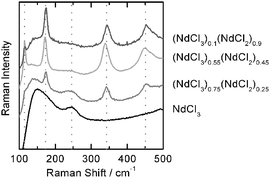Raman spectroscopic study of mixed valence neodymium and cerium chloride solutions in eutectic LiCl–KCl melts
Abstract
We have studied the Raman spectra of (NdCl2)–(

* Corresponding authors
a
Institute of Physical Chemistry, Physical Chemistry of Condensed Matter, University of Karlsruhe, Karlsruhe, Germany
E-mail:
nattland@ipc.uka.de
Fax: +49-721-608-4856
Tel: +49-721-608-2105
We have studied the Raman spectra of (NdCl2)–(

 Please wait while we load your content...
Something went wrong. Try again?
Please wait while we load your content...
Something went wrong. Try again?
V. M. Rodriguez-Betancourtt and D. Nattland, Phys. Chem. Chem. Phys., 2005, 7, 173 DOI: 10.1039/B414757J
To request permission to reproduce material from this article, please go to the Copyright Clearance Center request page.
If you are an author contributing to an RSC publication, you do not need to request permission provided correct acknowledgement is given.
If you are the author of this article, you do not need to request permission to reproduce figures and diagrams provided correct acknowledgement is given. If you want to reproduce the whole article in a third-party publication (excluding your thesis/dissertation for which permission is not required) please go to the Copyright Clearance Center request page.
Read more about how to correctly acknowledge RSC content.
 Fetching data from CrossRef.
Fetching data from CrossRef.
This may take some time to load.
Loading related content
